Environmental Defense Fund recently invited Julie Kuchepatov, founder of Seafood and Gender Equality, to have a conversation with three EDF team members on the role of women in small-scale fisheries in their respective countries. Julie spoke with Onesya Damayanti, Community Outreach Specialist, Indonesia; Layla Osman, Small-Scale Fisheries Manager, Humboldt Current; and Ana Suarez, Senior Specialist for Capacity Development, Partnerships and Global Inclusion, Mexico. In this conversation, Julie and our team explore the important roles of women in coastal communities around the world — and how women’s work in fisheries adds value in countless ways.
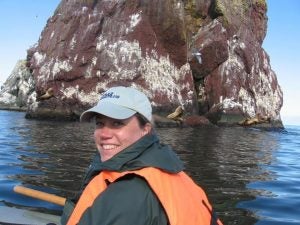 Julie: Thank you for joining in this conversation today. I’m excited to learn more about your experiences working with small-scale fisheries, especially when it comes to women in the fishing sector and their communities. Please introduce yourself and share how women participate in small-scale fisheries in your experience.
Julie: Thank you for joining in this conversation today. I’m excited to learn more about your experiences working with small-scale fisheries, especially when it comes to women in the fishing sector and their communities. Please introduce yourself and share how women participate in small-scale fisheries in your experience.
 Layla: I’m Layla Osman, Small-Scale Fisheries Manager, lead coordinator of the Small-Scale Fisheries Learning Networks in the Humboldt Current region of Chile and Peru. The main fisheries we are working with now are what we call “forgotten fish” — fish important for vulnerable coastal fishing communities, used for subsistence and local economies, and part of the fishing culture of coastal communities. We are working with several forgotten fish species from Los Rios region and the Juan Fernández Archipelago and Desventuradas Islands.
Layla: I’m Layla Osman, Small-Scale Fisheries Manager, lead coordinator of the Small-Scale Fisheries Learning Networks in the Humboldt Current region of Chile and Peru. The main fisheries we are working with now are what we call “forgotten fish” — fish important for vulnerable coastal fishing communities, used for subsistence and local economies, and part of the fishing culture of coastal communities. We are working with several forgotten fish species from Los Rios region and the Juan Fernández Archipelago and Desventuradas Islands.
First, the role of women is not yet completely understood, beginning with their role as caretakers of their home and children and their responsibility to manage household incomes and support their families in the best way. Second, women have contributed to small-scale fisheries through the time they put into development of fishing activities, with several roles such as seaweed harvesters, work in processing plants and associated activities, which add value to marine products, tourism and food initiatives. But there is hope: the role of women is changing slowly. As an example and sign of the times here in Chile, for the first time in the history of the Undersecretary of Fisheries — the government institution that manages fisheries — we have a woman as the leader. This year, a gender equity law for artisanal fisheries was launched, and a renowned woman national fisheries leader was chosen as the leader of the Latin American Union for Artisanal Fisheries. Women can care, but also, women can lead.
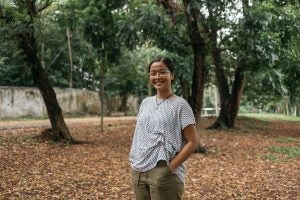 Onesya: I work in East Coast Lampung Province in Indonesia with the blue swimming crab fishery, where the majority of women play an important role. They help mend the nets, take out the blue swimming crab — or BSC — from the gillnet, craft the new gillnets for their husbands, work at the mini-plant at the village level, and play an important role as “middlewomen” in BSC trading.
Onesya: I work in East Coast Lampung Province in Indonesia with the blue swimming crab fishery, where the majority of women play an important role. They help mend the nets, take out the blue swimming crab — or BSC — from the gillnet, craft the new gillnets for their husbands, work at the mini-plant at the village level, and play an important role as “middlewomen” in BSC trading.
 Ana: I live in Mexico and split my time between strengthening knowledge and capacities to promote sustainable fishing with several Mexico fishing communities and promoting global inclusion at EDF so that our organization can better reflect the people and the places where we work. I have had the opportunity of working with women from different parts of Mexico — from the northern states like Sonora, Sinaloa and Baja California to southern states like Yucatán and Quintana Roo — and I’ve found two commonalities regarding women’s participation in fishing. They are highly engaged in the promotion of sustainable fishing, but not often included or recognized in decision-making processes.
Ana: I live in Mexico and split my time between strengthening knowledge and capacities to promote sustainable fishing with several Mexico fishing communities and promoting global inclusion at EDF so that our organization can better reflect the people and the places where we work. I have had the opportunity of working with women from different parts of Mexico — from the northern states like Sonora, Sinaloa and Baja California to southern states like Yucatán and Quintana Roo — and I’ve found two commonalities regarding women’s participation in fishing. They are highly engaged in the promotion of sustainable fishing, but not often included or recognized in decision-making processes.
Women tend to have a deeper understanding of the importance of thinking in the long run for themselves and their children. They also tend to be better at administrating resources and creating community; they are less individualistic players. Nonetheless, they very rarely occupy decision-making seats or participate in management processes.
In Mexico, official statistics from INEGI (Mexico Information and Geography Information Bureau) acknowledge that only 1 out of 10 jobs in the fishing sector are developed by women. However, that figure might underestimate their role, because women participate all along the value and production chain, from harvesting to processing and selling seafood. Globally, the figure increases to up to 5 jobs out of 10, according to the U.N. Food and Agriculture Organization. The lack of visibility of women’s work in the fishing sector in Mexico might be due to the lack of fishing tenure (they often work with their husband’s or father’s fishing permits) and the lack of access to information regarding their rights and how to exercise them.
Julie: It sounds like there are some common characteristics that define women’s participation in small-scale fisheries in your respective regions, such as lack of participation in leadership and decision-making around the resources and playing a large role in pre- and post- harvest activities like mending nets and processing. Their roles are generally invisible, but important. What is the importance of their roles?
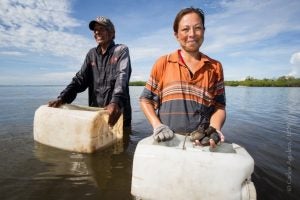 Ana: Women participate all along the production and value chain, from harvesting to putting food on the table. They know the business first-hand and, as a monitoring woman from the Sonoran curvina fishery once shared with me, they don’t want to be competition for men, but build a team together to help the fishing activity and their communities thrive.
Ana: Women participate all along the production and value chain, from harvesting to putting food on the table. They know the business first-hand and, as a monitoring woman from the Sonoran curvina fishery once shared with me, they don’t want to be competition for men, but build a team together to help the fishing activity and their communities thrive.
Women have a stronger connection with the community and are fierce environmental justice advocates. For instance, women cooperatives in Altata-Ensenada del Pabellón Coastal Lagoon, Sinaloa, besides fishing and participating in several management initiatives, such as a clam Fishery Improvement Project, also organize clean-up days or mangrove restoration campaigns. They have a more comprehensive view when it comes to thinking in the long run, and that is key for sustainability.
Layla: Women support and maintain the way of life, culture and development of coastal communities. They safely raise children, create community and put food on the table every day. Women are great leaders and administrators with skills that use the resources they have to ensure families and communities can prosper. Women are strongly aware of the state of their surrounding environments, so they are great leaders for sustainable management of marine resources.
Julie: It is clear that women are extremely important to the success of small-scale fisheries, their communities and their homes. They see what is happening in the environment and bring innovative and holistic solutions to address these challenges. So, why are they are excluded from leadership and decision-making processes in your experience?
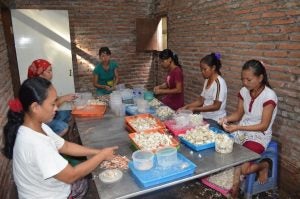 Onesya: In Lampung, the fishery is kind of a masculine culture; almost all the fishers are men. In the beginning of our work, women’s participation was very limited. One thing I noticed was the socio-economic aspect of community landscape knowledge was not in-depth. It is different if we include the women representatives, as they are the main actor at the household level.
Onesya: In Lampung, the fishery is kind of a masculine culture; almost all the fishers are men. In the beginning of our work, women’s participation was very limited. One thing I noticed was the socio-economic aspect of community landscape knowledge was not in-depth. It is different if we include the women representatives, as they are the main actor at the household level.
Ana: Women are mostly excluded because information about fishing tenure, organization and participation rights is not always available to them. This information is usually only shared with cooperative leaders or permit holders, who happen to be mostly men.
In the case of Mexico, fishery management councils are bodies of governance where management decisions are discussed among fishing and local authorities, fishers, academics, NGOs and other relevant stakeholders. In many fisheries, women don’t get a seat at the table because they don’t own fishing permits — a requisite to participate in fishery management councils. And they don’t often have fishing permits because they don’t know they can apply for one or form a cooperative to ask for a fishing concession. Empowering women with information and guidance regarding how to apply or exercise their organization and participation rights can be a game-changer, as it happened in Altata-Ensenada del Pabellón Coastal Lagoon, where now women have a seat at the table in the recently-formed fishery management council.
Layla: Women are excluded because they are relegated mainly to the house and to raising children. We live in a very male chauvinist culture where women are seen as something to be managed and used, without recognizing the great leadership and administrative abilities women have. Excluding women from decision-making results in poor management of marine resources, contamination or degradation of marine environments, less benefits from fishery negotiations, among other issues.
Julie: These are interesting responses and, again, there are very similar themes — chauvinistic cultures and lack of women’s knowledge and empowerment in the fisheries and communities. How do you think the fisheries in your region would look if women were no longer involved?
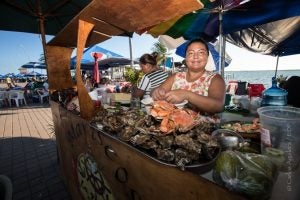 Ana: If women disappeared from the fishing activity, we wouldn’t be able to eat fish. It’s that simple. Women don’t often go into the water, but they do account for a significant number of fishing processing jobs, sales, exporting and cooking activities. If women disappear from the fishing industry, over 150 jobs would be lost in Atenea del Mar — the first processing plant in Baja California to be certified to export geoduck and clams to China and Europe, and whose founder and CEO is a woman. Yucatan’s famous maya octopus or red grouper wouldn’t be exported to the U.S. or Europe, because women account for a large number of jobs in processing plants. Some fisheries wouldn’t have valuable biological information for fisheries management if women didn’t conduct biological monitoring, as they do in Baja California Sur. Or, some fisheries would be at risk of being overfished if women who participate in catch monitoring efforts were not there to support the fishing activity. These are just a few examples.
Ana: If women disappeared from the fishing activity, we wouldn’t be able to eat fish. It’s that simple. Women don’t often go into the water, but they do account for a significant number of fishing processing jobs, sales, exporting and cooking activities. If women disappear from the fishing industry, over 150 jobs would be lost in Atenea del Mar — the first processing plant in Baja California to be certified to export geoduck and clams to China and Europe, and whose founder and CEO is a woman. Yucatan’s famous maya octopus or red grouper wouldn’t be exported to the U.S. or Europe, because women account for a large number of jobs in processing plants. Some fisheries wouldn’t have valuable biological information for fisheries management if women didn’t conduct biological monitoring, as they do in Baja California Sur. Or, some fisheries would be at risk of being overfished if women who participate in catch monitoring efforts were not there to support the fishing activity. These are just a few examples.
Layla: First, the culture and way of life of coastal communities would not be the same. Neither would all the different jobs related to fishing and marine value chains, where women fulfill several roles. The fishing activity without women would be a less diverse value chain, with less products and poorer communities, with little tourism or no unique gastronomic products.
Julie: These are amazing examples of the incredible necessity of women’s participation in these fisheries and what would happen if they disappeared. In the course of your work, what are some tools you use to be more inclusive of women in fisheries and fishing communities?
 Layla: Women need to have a voice and be heard. Learning networks and the SSF Hub are great initiatives to inform people, bring everyone together and give a voice to those who do not have one. In our daily work and how we build our projects, we need to ensure the participation of women — having DEI and EJ at the center of our work.
Layla: Women need to have a voice and be heard. Learning networks and the SSF Hub are great initiatives to inform people, bring everyone together and give a voice to those who do not have one. In our daily work and how we build our projects, we need to ensure the participation of women — having DEI and EJ at the center of our work.
Ana: For EDF Mexico and Latin America, we ensure that women can access all our workshops and capacity-building activities. At the same time, we accompany them in processes that would help them have a seat at the table when it comes to fisheries management decisions and promoting sustainable fishing and community engagement.
We are taking other actions, such as opening more spaces for women to share their own stories (in media, social media, events, symposiums, etc.) and making them visible to decision-makers and other women who might be willing to participate more, but don’t know how. Their voices need to be heard; we are just space facilitators.
I also acknowledge that we still have work to do to fully integrate a gender equity lens into our work. As a team, we need to learn and be more aware of gender inequalities in the field and politics and know how to address them in an assertive and transformative way. We need to continue asking ourselves who is not at the table, and why, to find a way to even the field for everyone.
Julie: As a leader of a nonprofit dedicated to building gender equality and women’s empowerment in global seafood production, what can I do to support women in the fisheries and communities where you work?
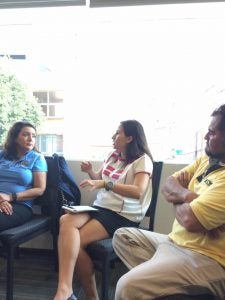 Ana: When organizing an event, decision-making or participatory meetings, ask yourself who is being left behind and why. That exercise could lead to the next and most important question: how to include them and adapt our meetings and processes.
Ana: When organizing an event, decision-making or participatory meetings, ask yourself who is being left behind and why. That exercise could lead to the next and most important question: how to include them and adapt our meetings and processes.
In the case of women, aim for parity, or at least make sure that women have a seat and a space to share their stories. If you are organizing an event or a panel or forum, make sure that you have women invited as panelists or presenters; take the time to listen to their stories and offer assistance in preparation. Many could be new to this type of spotlight, and it can be overwhelming sometimes.
Also, as someone who has had to adapt many capacity-building processes to virtuality, acknowledge that the digital gap is wider for women than for men and offer options for women to connect or participate in virtual meetings. At NGOs, we often think that people are as comfortable with technology as we are. However, we forget about connectivity issues or access to technological devices to connect. So, to promote equity in a virtual space, make sure to adapt your meetings and sessions so participants can access or connect through multiple channels (internet, phone, laptop, mobile, etc.), and build an environment that would make everyone feel comfortable. For example, dedicate time to technological assistance before and during sessions and think of methodologies that could involve all participants.
Also, women tend to participate less in virtual meetings — and our voices are not as loud as men — so think of ways to include them: use a virtual chat box to share opinions or questions, use polls or survey tools, do a “round robin” to discuss certain issues, and if the space is safe enough, ask them directly what their thoughts are. These are just a few options.
Julie: As a consumer, my seafood purchases are limited by what is available in the store, so my choice depends on global, and local, seafood buyers. What should people who buy seafood from your region know about the seafood they are purchasing? What would you tell them if you could?
Onesya: The BSC market chain has involved many people in the community, including fishers, women and processors. The BSC fishery has a big impact on the economy in Eastern Lampung coastal communities. As buyers, we need to think about the significance of the BSC fishery in the local community in regard to the contribution of their livelihoods.
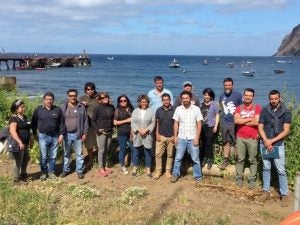 Layla: It is very important to buy seafood produced in your region, such as fish caught in the waters near you. Not only because it is healthier food, but also to support the coastal communities in your region. It does not make sense to buy seafood products from abroad when you have diverse, unique, high-quality seafood where you live.
Layla: It is very important to buy seafood produced in your region, such as fish caught in the waters near you. Not only because it is healthier food, but also to support the coastal communities in your region. It does not make sense to buy seafood products from abroad when you have diverse, unique, high-quality seafood where you live.
Ana: First, to honor and recognize the people behind our plate: from the person that goes into the water to the person who puts it on our table. Fishing is about people too — not only fish.
Second, to ask who caught that fish and where, so that you can make sure you’re not consuming something during no-fishing season, or from a place where fishing is not permitted. When possible, support local sustainable fishers.
Julie: Thank you Onesya, Ana and Layla for this candid conversation about women in fisheries. It’s always extremely helpful to hear such stories from the source, so I appreciate your views and wish you all incredible success in your future work with these fishing communities.










